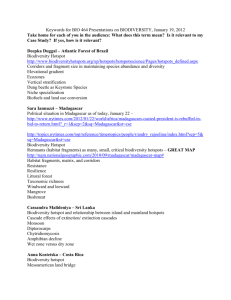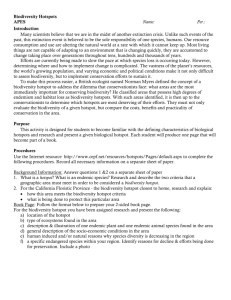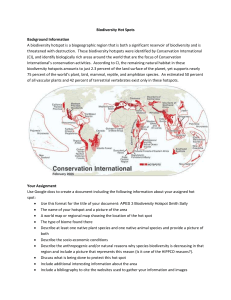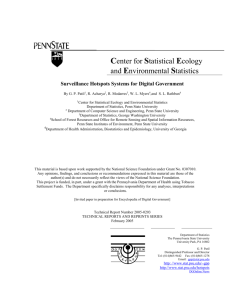Hotspot Detection - Penn State Department of Statistics
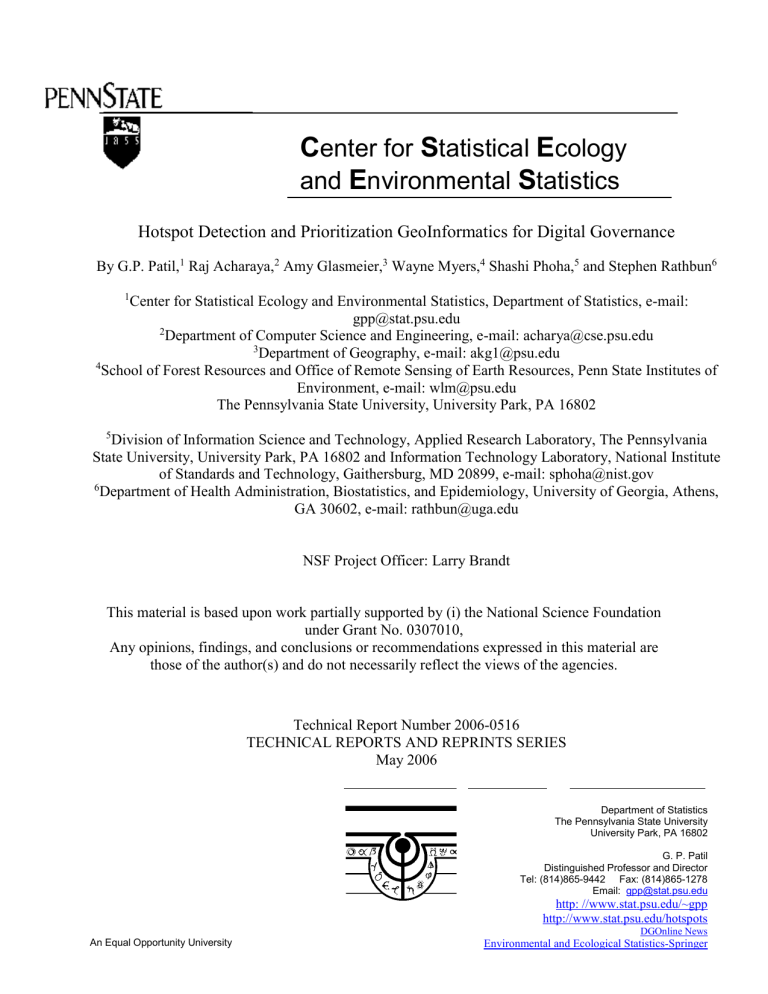
C
enter for
S
tatistical
E
cology and
E
nvironmental
S
tatistics
Hotspot Detection and Prioritization GeoInformatics for Digital Governance
By G.P. Patil,
1
Raj Acharaya,
2
Amy Glasmeier,
3
Wayne Myers,
4
Shashi Phoha,
5
and Stephen Rathbun
6
1
Center for Statistical Ecology and Environmental Statistics, Department of Statistics, e-mail: gpp@stat.psu.edu
2
Department of Computer Science and Engineering, e-mail: acharya@cse.psu.edu
3
Department of Geography, e-mail: akg1@psu.edu
4
School of Forest Resources and Office of Remote Sensing of Earth Resources, Penn State Institutes of
Environment, e-mail: wlm@psu.edu
The Pennsylvania State University, University Park, PA 16802
5 Division of Information Science and Technology, Applied Research Laboratory, The Pennsylvania
State University, University Park, PA 16802 and Information Technology Laboratory, National Institute of Standards and Technology, Gaithersburg, MD 20899, e-mail: sphoha@nist.gov
6 Department of Health Administration, Biostatistics, and Epidemiology, University of Georgia, Athens,
GA 30602, e-mail: rathbun@uga.edu
NSF Project Officer: Larry Brandt
This material is based upon work partially supported by (i) the National Science Foundation under Grant No. 0307010,
Any opinions, findings, and conclusions or recommendations expressed in this material are those of the author(s) and do not necessarily reflect the views of the agencies.
Technical Report Number 2006-0516
TECHNICAL REPORTS AND REPRINTS SERIES
May 2006
An Equal Opportunity University
Department of Statistics
The Pennsylvania State University
University Park, PA 16802
G. P. Patil
Distinguished Professor and Director
Tel: (814)865-9442 Fax: (814)865-1278
Email: gpp@stat.psu.edu
http: //www.stat.psu.edu/~gpp http://www.stat.psu.edu/hotspots
DGOnline News
Environmental and Ecological Statistics-Springer
Page 2
Hotspot Detection and Prioritization GeoInformatics for Digital Governance
G.P. Patil,
1
Raj Acharya,
2
Amy Glasmeier,
3
Wayne Myers,
4
Shashi Phoha,
5 and Stephen Rathbun
6
1
Center for Statistical Ecology and Environmental Statistics, Department of Statistics, e-mail: gpp@stat.psu.edu
2
Department of Computer Science and Engineering, e-mail: acharya@cse.psu.edu
3
Department of Geography, e-mail: akg1@psu.edu
4 School of Forest Resources and Office of Remote Sensing of Earth Resources, Penn State Institutes of
Environment, e-mail: wlm@psu.edu
The Pennsylvania State University, University Park, PA 16802
5
Division of Information Science and Technology, Applied Research Laboratory, The Pennsylvania State
University, University Park, PA 16802 and Information Technology Laboratory, National Institute of Standards and Technology, Gaithersburg, MD 20899, e-mail: sphoha@nist.gov
6
Department of Health Administration, Biostatistics, and Epidemiology, University of Georgia, Athens, GA
30602, e-mail: rathbun@uga.edu
1. Introduction
A declared purpose of digital governance is to empower public for information access and analysis to enable transparency, accuracy, and efficiency for societal good at large. Hotspot detection and prioritization become natural undertakings as a result of the information access. Hotspot means spot that is hot, that can be of special interest or concern. Hotspot means something unusual—an anomaly, aberration, outbreak, elevated cluster, critical area, etc. The immediate need can be for monitoring, etiology, management, or early warning.
Responsible factors can be natural, accidental, or intentional. Geoinformatic surveillance for spatial and temporal hotspot detection and prioritization is crucial in the 21 st century. And so also the need for geoinformatic surveillance decision support system equipped with the next generation of geographic hotspot detection, prioritization, and early warning within emerging hotspots.
This chapter describes ongoing cross-disciplinary research and some of the interesting results for geospatial and spatiotemporal hotspot detection and prioritization, driven by a diverse variety of case studies and issues of interest to government agencies, academia, and the private sector. The chapter is based on cutting edge statistical research, using a variety of data products and sources across geographic regions and across networks. It deals with national and international applications of societal importance, such as public health, ecohealth, biodiversity, invasive species, watershed management, persistent poverty, sensor networks, homeland security, among others. It has potential to lead to a sophisticated next generation analytical and computational decision support system beyond the present day health area based circular spatial scan system.
Our innovation employs the notion of upper level set, and is accordingly called the upper level set scan system.
See Patil and Taillie, 2004a and Patil et al., 2006a.
Our prioritization innovation provides capability for prioritization and ranking of detected hotspots and objects based on multiple criteria indicators without integration of indicators into an index. It employs Hasse diagrams for visualization, and partially ordered sets and Markov Chain Monte Carlo methods for analysis.
Resulting prioritizations and rankings reflect the contrasting requirements of each application and also of varying stakeholders, while employing a common framework for hotspot detection and prioritization. It is accordingly called the poset prioritization and ranking system. See Patil and Taillie, 2004b and Patil et al.,
2006b.
An Equal Opportunity University
2. Literature Review: Fundamental Methodologies and Computational Techniques.
We first present the scan statistic methodology and then the prioritization methodology.
Page 3
2.1. Scan Statistic Methodology
Although a wide variety of methods have been proposed for modeling and analyzing spatial data, the spatial scan statistic (Kulldorff and Nagarwalla 1995; Kulldorff 1997) has become a popular method for detection and evaluation of disease clusters. In space-time, the scan statistic can provide early warning of disease outbreaks and can monitor their spatial spread. With innovative modifications, scan statistic methods can be used for hotspot analysis in any field.
Spatial Scan Statistic Background.
A region R of Euclidian space is tessellated or subdivided into cells that will be labeled by the symbol a . Data is available in the form of a count Y (non-negative integer) on each a cell a . In addition, a “size” value A a
is associated with each cell a . The cell sizes A a
are regarded as known and fixed, while the cell counts Y are random variables. In the disease setting, the response a
Y is the number a of diseased individuals within the cell and the size A a
is the total number of individuals in the cell. The disease rate within the cell is the ratio Y a
/ A a
. The spatial scan statistic seeks to identify “hotspots” or clusters of cells that have an elevated rate compared with the rest of the region, and to evaluate the statistical significance ( p value) of each identified hotspot. These goals are accomplished by setting up a formal hypothesis-testing model for a hotspot. The null hypothesis asserts that there is no hotspot, i.e., that all cells have (statistically) the same rate. The alternative states that there is a cluster Z such that the rate for cells in Z is higher than for cells outside
Z . An essential point is that the cluster Z is an unknown parameter that has to be estimated. Likelihood methods are employed for both the estimation and significance testing. Candidate clusters for Z are referred to as zones. Ideally, maximization of the likelihood should search across all possible zones, but their number is generally too large for practical implementation. Various devices (e.g., expanding circles) are employed to reduce the list of candidate zones to manageable proportions. Significance testing for the spatial scan statistic employs the likelihood ratio test. Monte Carlo simulation is used to determine the needed null distributions.
Explication of a likelihood function requires a distributional model (response distribution) for the response Y in cell a . This distribution can vary from cell to cell but in a manner that is regulated by the size a variable A a
. Thus, A a
enters into the parametric structure of the response distribution. In disease surveillance, response distributions are generally taken as either binomial or Poisson, leading to comparatively simple likelihood functions. The scan statistic that we propose allows continuous response distributions and complex likelihood functions.
Limitations of Current Scan Statistic Methodology.
Available scan statistic software suffers from several limitations. First, circles have been used for the scanning window, resulting in low power for detection of irregularly shaped clusters (Fig. 1). Second, the response variable has been defined on the cells of a tessellated geographic region, preventing application to responses defined on a network (stream network, water distribution system, highway system, etc.). Third, response distributions have been taken as discrete (specifically, binomial or Poisson). Finally, the traditional scan
An Equal Opportunity University
statistic returns only a point estimate for the hotspot but does not attempt to assess estimation uncertainty. We address these limitations.
Page 4
Fig. 1.
Scan statistic zonation for circles ( left ) and space-time cylinders ( right )
Our Approach .
In our approach to the scan statistic, the geometric structure that carries the numerical information is an abstract graph consisting of (i) a finite collection of vertices and (ii) a finite set of edges that join certain pairs of distinct vertices. A tessellation determines such a graph: vertices are the cells of the tessellation and a pair of vertices is joined by an edge whenever the corresponding cells are adjacent. A network determines such a graph directly.
Each vertex in the graph carries three items of information: (i) a size variable that is treated as known and nonrandom, (ii) a response variable whose value is regarded as a realization of some probability distribution, and
(iii) the probability distribution itself, which is called the response distribution. Parameters of the response distribution may vary from vertex to vertex, but the mean response (i.e., expected value of the response distribution) should be proportional to the value of the size variable for that vertex. The response rate is the ratio
Response / Size
and a hotspot is a collection of vertices for which the overall response rate is unusually large.
ULS Scan Statistic.
We have a new version of the spatial scan statistic designed for detection of hotspots of arbitrary shapes and for data defined either on a tessellation or a network. Our version looks for hotspots from among all connected components of upper level sets of the response rate and is therefore called the upper level set (ULS) scan statistic. The method is adaptive with respect to hotspot shape since candidate hotspots have their shapes determined by the data rather than by some a priori prescription like circles or ellipses. This data dependence is taken into account in the Monte Carlo simulations used to determine null distributions for hypothesis testing.
We also compare performance of the ULS scanning tool with that of the traditional spatial scan statistic. The key element here is enumeration of a searchable list of candidate zones Z . A zone is, first of all, a collection of vertices from the abstract graph. Secondly, those vertices should be connected (Fig. 2) because a geographically scattered collection of vertices would not be a reasonable candidate for a “hotspot.” Even with this connectedness limitation, the number of candidate zones is too large for a maximum likelihood search in all but the smallest of graphs. We reduce the list of zones to searchable size in the following way. The response rate at vertex a is G a
Y a
/ A a
. These rates determine a function a
G a
defined over the vertices in the graph.
This function has only finitely many values (called levels) and each level g determines an upper level set
U g defined by U g
{ : a
g } . Upper level sets do not have to be connected but each upper level set can be decomposed into the disjoint union of connected components. The list of candidate zones Z for the ULS scan statistic consists of all connected components of all upper level sets. This list of candidate zones is denoted
An Equal Opportunity University
Page 5 by
ULS
. The zones in
ULS are certainly plausible as potential hotspots since they are portions of upper level sets. Their number is small enough for practical maximum likelihood search—in fact, the size of
ULS does not exceed the number of vertices in the abstract graph (e.g., the number of cells in the tessellation). Finally,
ULS becomes a tree under set inclusion, thus facilitating computer representation. This tree is called the ULStree (Fig. 3); its nodes are the zones Z
ULS
and are therefore collections of vertices from the abstract graph.
Leaf nodes are (typically) singleton vertices at which the response rate is a local maximum; the root node consists of all vertices in the abstract graph.
Fig. 2.
Connectivity for tessellated regions. The collection of shaded cells on the left is connected and, therefore, constitutes a zone.
The collection on the right is not connected.
Finding the connected components for an upper level set is essentially the issue of determining the transitive closure of the adjacency relation defined by the edges of the graph. Several generic algorithms are available in the computer science.
Tessellated Region R
Fig. 3.
A confidence set of hotspots on the ULS tree. The different connected components correspond to different hotspot loci while the nodes within a connected component correspond to different delineations of that hotspot.
Hotspot Confidence Sets.
The hotspot MLE is just that—an estimate. Removing some cells from the MLE and replacing them with certain other cells can generate an estimate that is almost as plausible in the likelihood sense. We will express this uncertainty in hotspot delineation by a confidence set of hotspot zones—a subset of the ULS tree (Fig. 3).
We will determine the confidence set by employing the standard duality between confidence sets and hypothesis testing in conjunction with the likelihood ratio test. The confidence set also lets us assign a numerical hotspot-membership rating to each cell (e.g., county, zip code, census tract). The rating is the percentage of zones (in the confidence set) that include the cell under consideration (Fig. 4). A map of these ratings, with superimposed MLE, provides a visual display of uncertainty in hotspot delineation
.
An Equal Opportunity University
Page 6
Fig. 4.
Hotspot-membership rating. Cells in the inner envelope belong to all plausible estimates (at specified confidence level); cells in the outer envelope belong to at least one plausible estimate. The MLE is nested between the two envelopes.
Typology of Space-Time Hotspots.
Scan statistic methods extend readily to the detection of hotspots in space-time. The space-time version of the circle-based scan employs cylindrical extensions of spatial circles and cannot detect the temporal evolution of a hotspot (Fig. 1). The space-time generalization of the ULS scan detects arbitrarily shaped hotspots in spacetime. This lets us classify space-time hotspots into various evolutionary types—a few of which appear on the left hand side of Fig. 5. The merging hotspot is particularly interesting because, while it comprises a connected zone in space-time, several of its time slices are spatially disconnected.
Space (census tract) Space (census tract)
Space (census tract) Space (census tract)
Fig. 5.
The four diagrams on the left depict different types of space-time hotspots. The spatial dimension is shown schematically on the horizontal and time is on the vertical. The diagrams on the right show the trajectory (sequence of time slices) of a merging hotspot.
2.2 Prioritization Methodology
We address the question of ranking a collection of objects, such as initial hotspots, when a suite of indicator values is available for each member of the collection. The objects can be represented as a cloud of points in indicator space, but the different indicators typically convey different comparative messages and there is no unique way to rank the objects. A conventional solution assigns a composite numerical score to each object by combining the indicator information in some fashion. Every such composite involves judgments (often arbitrary or controversial) about tradeoffs among indicators. We take the view that the relative positions in indicator space determine only a partial ordering (Neggers and Kim 1998) and that a given pair of objects may not be inherently comparable. Working with Hasse diagrams (Neggers and Kim 1998) of the partial order, we study the collection of all rankings that are compatible with the partial order.
Multiple Indicators and Partially Ordered Sets (Posets).
The scan statistic ranks hotspots based on their statistical significance (likelihood values). But, other factors need to be considered in prioritizing hotspots, such as mean response, peak response, geographical extent, population size, economic value, etc. We therefore envision a suite of indicator values attached to each hotspot
An Equal Opportunity University
Page 7 with large indicator values signifying greater hotspot importance. Different indicators reflect different criteria and may rank the hotspots differently. In mathematical terms, the suite of indicators determines a partial order on the set of hotspots. Thus, if a and b are hotspots, we say that b is inherently more important than a and we write a b if ( )
( ) for all of the indicators I . If distinct hotspots are distinct in indicator space, the relation has the three defining properties of a partial order: (i) transitive: a b and b c implies a c ; (ii) anti-symmetric: a b and b a implies a
b ; and (iii) reflexive: a a . Certain pairs a , b of hotspots may not be comparable under this importance ordering since, for example, there may be indicators such that
I a
1
I b
1
( ) but I a
2
I b
2
( ) . In this case, hotspot b would be located in the fourth quadrant of Fig. 6.
Because of these inherent incomparabilities, there are many different ways of ranking the hotspots while remaining consistent with the importance ordering. A given hotspot a can therefore be assigned different ranks depending upon who does the ranking. It turns out that these different ranks comprise an interval (of integers) called the rank interval of a . Rank intervals can be calculated directly from the partial order. First, define B ( a ) to be the number of hotspots b for which a b , i.e., the count of the first quadrant in Fig. 6. Next, define W ( a ) as B ( a ) plus the number of hotspots that are not comparable with a ; this is the total count for quadrants 1, 2, and
4 in Fig. 6. The rank interval of a then consists of all integers r such that B ( a )
r
W ( a ). The length, W ( a )
B ( a ), of this interval is called the rank-ambiguity of hotspot a .
Not comparable with a Bigger than a
Count = B ( a ) =best possible rank for a
(rank 1 is best)
Smaller than a a
Not comparable with a
Count = W ( a ) = worst possible rank for a
Indicator 1
Fig. 6.
Regions of comparability and incomparability for the inherent importance ordering of hotspots. Hotspots form a scatterplot in indicator space and each hotspot partitions indicator space into four quadrants.
Hasse Diagrams and Linear Extensions.
Posets can be displayed as Hasse diagrams (Fig. 7). A Hasse diagram is a graph whose vertices are the hotspots and whose edges join vertices that cover one another in the partial order. Hotspot b is said to cover a in the partial order if three things happen: (i) a b ; (ii) a
b ; and (iii) if a x b then either x
a or x
b . In words, b is strictly above a and no hotspots are strictly between a and b . Each of the many possible ways of ranking the elements of a poset is referred to as a linear extension. The Hasse diagram of each linear extension appears as a vertical graph (Fig. 7). Enumeration of all possible linear extensions can be accomplished algorithmically as follows. The top element of a linear extension can be any one of the maximal elements of the
Hasse diagram. Select any one of these maximal elements and remove it from the Hasse diagram. The second ranked element in the linear extension can be any maximal element from the reduced Hasse diagram. Select any of these and proceed iteratively. The procedure can be arranged as a decision tree (Fig. 7) and each path through the tree from root node to leaf node determines one linear extension.
An Equal Opportunity University
Page 8
Fig. 7.
Hasse diagram of a hypothetical poset ( left ), some linear extensions ( middle ), and a decision tree giving all 16 possible linear extensions ( right ). Links shown in dashed/red (called jumps) are not implied by the partial order. The six members of the poset can be arranged in 6!=720 different ways, but only 16 of these are valid linear extensions.
Linearizing a Poset.
The suite of indicators determines only a partial order on the hotspots, but it is human nature to ask for a linear ordering. We ask: Is there some objective way of mapping the partial order into a linear one? Our solution treats each linear extension in Fig. 7 as a voter and we apply the principle of majority rule. Focus attention on some member a of the poset and ask how many of the voters give a a rank of 1? 2? Etc. The results are displayed in Fig. 8, where each row of the table is called a rank-frequency distribution. The cumulative forms of these rank-frequency distributions form a new poset with stochastic ordering of distributions as the order relation. For this example, the new poset is already a linear ordering (see Fig. 8).
16
12
8
4 c d a b e f
0
1 2 3 4 5 6
Rank
Fig. 8.
( Left) Rank-frequency table for the poset of Fig. 7. Each row gives the number of linear extensions that assign a given rank r to the corresponding member of the poset. Each row is referred to as a rank-frequency distribution. ( Right )
Cumulative rank-frequency distributions for the poset of Fig. 7. The curves are stacked one above the other giving a linear ordering of the elements: a b c d e f . f f f a a f f f f f b, c (tied)
Fig. 9.
( Left ) Two iterations of the CRF operator are required to transform this partial order into a linear order. ( Right ) A poset for which the CRF operator produces ties.
An Equal Opportunity University
Page 9
We refer to the above procedure as the cumulative rank-frequency (CRF) operator. In general, it does not transform a partial order into a linear order in a single step; instead, multiple iterations may be required (Fig. 9).
The CRF operator can also produce ties in the final linear ordering.
3. Illustrative Applications and Case Studies
Network analysis of biological integrity in freshwater streams.
This study will employ the network version of the upper level set scan statistic to characterize biological impairment along the rivers and streams of Pennsylvania and to identify subnetworks that are badly impaired. The state Department of
Environmental Protection is determining indices of biological integrity (IBI) at about
15,000 sampling locations across the Commonwealth. Impairment will be measured by a complemented form of these IBI values. We will also use remotely sensed landscape variables and physical characteristics of the streams as explanatory variables in order to account for impairment hotspots. Critical stream subnetworks that remain unaccounted for after this filtering exercise become candidates for more detailed modeling and site investigation. See Wardrop et al. (2005).
Watershed prioritization for impairment and vulnerability. in
This study will develop a prioritization model for watersheds (12-digit HUCs) of the Mid-Atlantic Highlands. A suite of indicators will be identified to assess each watershed’s susceptibility to impairment (vulnerability). A second suite of indicators will measure actual stress or disturbance for each watershed. The watersheds will then be ranked according to each of the two separate sets of indicators. The proposed prioritization methodology will be used for ranking purposes. Each watershed is thus assigned a pair of ranks indicating its vulnerability status and its disturbance status. The pairs of ranks yield a scatter plot the disturbance vulnerability plane. The four quadrants in this plot have distinctly different management implications, as depicted in the accompanying diagram. Disturbance will be measured by stressor variables such as: excess sediment, riparian degradation, mine drainage, excess nutrients, exotic species, agriculture (esp. on slopes), road crossings, forest fragmentation, and indices biological impairment.
Vulnerability primarily reflects physical characteristics and natural features of the watershed and can be measured by: hydrogeomorphology (HGM), climate, aspect, slope, stream sinuosity, soil type, bedrock, and water source. Products include: a procedure for classifying watersheds by their features and condition, a taxonomy of Mid-Atlantic watersheds, and a set of monitoring and restoration options for each watershed class that can assist managers in developing TMDL (total maximum daily load) plans, Patil et al. (2000).
Tasking of a self-organizing oceanic surveillance mobile sensor network.
An Equal Opportunity University
Page 10
The Autonomous Ocean Sampling Network Simulator (AOSN) is used to study coordination and control strategies for high-resolution, spatio-temporally coordinated surveys of oceanographic fields such as bathymetry, temperature and currents using autonomous unmanned undersea vehicles. Currently, the network of mobile sensor platforms is autonomous and self-organizing once given highlevel tasking from an external tactical coordinator. This case study proposes to use upper level set scan statistic theory to identify hotspots in data gathered by the sensor network and use this information to dynamically task mobile sensor platforms so that more data can be gathered in the areas of interest. By detecting hotspots and tasking accordingly, network resources are not wasted on mapping areas of little change. The ability of the sensor network to dynamically task its own components expands the network’s mission and increases the reactivity to changing conditions in a highly dynamic environment. See Phoha et al. (2001).
Persistent Poverty Patch Dynamics and Poverty Eradication Policy.
As Glasmeier (2004) puts it, “the United States is a nation pulling apart to a degree unknown in the last twentyfive years. Despite more than a decade of strong national economic growth, many of America’s communities are falling far behind median national measures of economic health.” The federal anti-poverty programs have had little success in eradicating pockets of persistent poverty. In order to help formulate promising policies, it has become important to analyze spatial and temporal compositions of persistent poverty at multiple scales and examine the persistent poverty patch trajectories over the years in various urban and rural regions. Glasmeier
(2004) speaks of several dimensions of tract poverty in metropolitan areas during 1970-90, such as, persistent, concentrated, growing, and shifting (Figure 11). The case study under consideration is motivated to answer the following question: can spatial-temporal patterns of poverty hotspots provide clues to the causes of poverty and lead to improved location-specific anti-poverty policy? Our approach will be used to detect shifting poverty hotspots, coalescence of neighboring hotspots, or their growth for this case study.
Fig. 11.
. Shifting poverty, Oakland, CA, 1970-1980-1990.
An Equal Opportunity University
Page 11
Cyber Security and Computer Network Diagnostics:
Securing the nation’s computer networks from cyber attacks is an important aspect of national Homeland
Security. Network diagnostic tools aim at detecting security attacks on computer networks. Besides cyber security, these tools can also be used to diagnose other anomalies such as infrastructure failures, and operational aberrations. Hotspot detection forms an important and integral part of these diagnostic tools for discovering correlated anomalies. The project research can be used to develop a network diagnostic tool at a functional level. The goal of network state models is to obtain the temporal characteristics of network elements such as routers, typically in terms of their physical connectivity, resource availability, occupancy distribution, blocking probability, etc. We have done prior work in developing network state models for connectivity, and resource availability. We have also developed models for studying the equilibrium behavior of multi-dimensional loss systems (Acharya, 2003). The probabilistic finite state automaton (PFSA) describing a net element can be obtained from the output of these state models. A time-dependent crisis-index is determined for each network element, which measures their normal behavior pattern compared to crisis behavior. The crisis-index is the numerical distance between the stochastic languages generated by the normal and crisis behavior. The crisisindex is the numerical distance between the stochastic languages generated by the normal and crisis automata.
We plan to use the variation distance between probability measures, although other distances will also be considered. The crisis behavior can be obtained from past experience. The crisis indices over a collection of network elements are then used for hot-spot detection using scan statistic methodology. These hot spots help to detect coordinated security attacks geographically spread over a network. See Figure 12.
Additional application of PFSA include the tasking of the self-organizing surveillance mobile sensor networks, geotelemetry with wireless sensor networks, video-mining networks, and syndromic surveillance in public health with hospital networks.
Fig. 12.
( left ) The overall procedure, leading from admissions records to the crisis index for a hospital. The hotspot detection algorithm is then applied to the crisis index values defined over the hospital network. ( right )
The -machine procedure for converting an event stream into a parse tree and finally into a probabilistic finite state automaton (PFSA).
Network Applications and New York City Subway System Syndromic Surveillance Data:
For certain problems, there is an underlying network structure on which we will want to perform the cluster detection and evaluation. For example, the New York City Health Department is monitoring the New York subway system and water distribution networks for bioterrorism attacks. In such a scenario, a circular scan statistic is not useful as two individuals close to each other in Euclidian distance may be very far from each other along the network. However, the ULS methods will be employed for the detection and evaluation of clusters on a predefined network. The essentially linear structure of these networks, compared with tessellationderived networks, is expected to have a major impact on the form of the null distributions and their parametric approximations.
An Equal Opportunity University
Page 12
The New York City Department of Health (DOH) and Metropolitan Transportation Authority (MTA) began monitoring subway worker absenteeism in October 2001 as one of several surveillance systems for the early detection of disease outbreaks. Each day the MTA transmits an electronic line list of workers absent the previous day, including work location and reason for absence. DOH epidemiologists currently monitor temporal trends in absences in key syndrome categories (e.g., fever-flu or gastrointestinal illness). Analytic techniques are needed for detecting clustering within the subway network.
Conclusion
We now live in the age of geospatial technologies. The age old geographic issues of societal importance are now thinkable and analyzable. The geography of disease is now just as doable as genetics of disease, for example. And it is possible to pursue it in an intelligent manner with the rapidly advancing information technology around.
Government agencies continue to require meaningful summaries of georeferenced data to support policies and decisions involving geographic assessments and resource allocations. So also the public with initiatives of digital governance in the country and around the world. Surveillance geoinformatics of spatial and spatiotemporal hotspot detection and prioritization is a critical need for the 21 st
century.
This chapter briefly describes a prototype geoinformatic hotspot surveillance system for hotspot delineation and prioritization and provides a variety of case studies and illustrative applications of societal importance. The prototype system consists of modules for hotspot detection and delineation, and for hotspot prioritization.
Fig. 13.
Framework for the Geoinformatic Hotspot Surveillance (GHS) system.
5. Acknowledgements.
This material is based upon work supported by (i) the National Science Foundation Grant No. 0307010, (ii) the
United States Environmental Protection Agency under Grant No. R-828684 and Grant No. RD-83244001 and
(iii) the Pennsylvania Department of Health using Tobacco Settlement Funds under Grant No. ME 01324. Any opinions, findings, and conclusions or recommendations expressed in this material are those of the author(s) and do not necessarily reflect the views of the agencies.
An Equal Opportunity University
Page 13
6. References:
Glasmeier A (2004) An atlas of poverty in America: One nation, pulling apart, 1960-2003, Routledge, Oxford,
UK.
Kulldorff M (1997) A spatial scan statistic. Communications in Statistics: Theory and Methods, 26:1481–1496.
Kulldorff M, Nagarwalla N (1995) Spatial disease clusters: Detection and inference. Statistics in Medicine,
14:799–810
Neggers J, Kim HS (1988) Basic Posets. World Scientific, Singapore.
Patil GP, Johnson GD, Myers WL, Taillie C (2000) Multiscale statistical approach to critical-area analysis and modeling of watersheds and landscapes. Pages 293-310 in Statistics for the 21st Century: Methodologies for Applications of the Future, C. R. Rao and G. J. Szekely, eds. Marcel Dekker, New York.
Patil GP, Taillie C (2004a) Upper level set scan statistic for detecting arbitrarily shaped hotspots.
Environmental and Ecological Statistics, 11:183-197.
Patil GP, Taillie C (2004b) Multiple indicators, partially ordered sets, and linear extensions: Multi-criterion ranking and prioritization. Environmental and Ecological Statistics, 11:199-228.
Patil GP, Duczmal L, Haran M, Patankar P (2006a) On PULSE: The progressive upper level set scan statistic system for geospatial and spatiotemporal hotspot detection. In: The 7 th Annual International Conference on Digital Government Research, San Diego, CA, May 21-24, 2006.
Patil GP, Bhat KS, Kase M (2006b) Multicriterion prioritization and differential weights, stepwise aggregation,
Hasse diagrams, and Poset cumulative rank frequency operators. In: The 7 th
Annual International
Conference on Digital Government Research, San Diego, CA, May 21-24, 2006.
Phoha S, Peluso E, Culver RL (2001). A high fidelity ocean sampling mobile network (SAMON) simulator tested for evaluating intelligent control of unmanned underwater vehicles. Revised version submitted to
IEEE Journal for Ocean Engineering, Special Edition, June 2001.
Wardrop DH, Bishop JA, Easterling M, Hychka K, Myers WL, Patil GP, Taillie C (2005) Use of landscape and land use parameters for classification and characterization of watersheds in the Mid-Atlantic across five physiographic provinces. Environmental and Ecological Statistics, 12:209-223.
7. Suggested Readings:
7.1. Patil GP, Taillie C (2004a) Upper level set scan statistic for detecting arbitrarily shaped hotspots.
Environmental and Ecological Statistics, 11:183-197. (A basic proof of concept paper for upper level set scan system.)
7.2 Patil GP, Taillie C (2004b) Multiple indicators, partially ordered sets, and linear extensions: Multicriterion ranking and prioritization. Environmental and Ecological Statistics , 11:199-228. (A basic proof of concept paper for poset prioritization and ranking system.)
An Equal Opportunity University
Page 14
7.3 Kulldorff M, Nagarwalla N (1995) Spatial disease clusters: Detection and inference. Statistics in
Medicine, 14:799–810. (A basic paper for circular spatial scan.)
8. Online Resources:
8.1
http://www.stat.psu.edu/hotspots
(A project website providing project activities, products, publications, and events.)
8.2
http://www.dgrc.org/dgo2006/papers/workshops.jsp#hotspot
(Article on the workshop program on hotspot geoinformatics.)
8.3
http://www.satscan.org
(Freeware for circular spatial scan program and information.)
8.4
http://www.getsynapsed.de/
(Freeware for academia for Hasse program for Windows.)
8.5
http://www.stat.psu.edu/~gpp
(Website of the Penn State Center for Statistical Ecology and Environmental Statistics—Home base of the digital government research project for hotspot geoinformatics.)
9. Questions for Discussion:
9.1 How to improve the quality and quantity of the ULS nodal tree and thus introduce PULSE –
Progressive ULS Scan.
9.2 How to formulate and conduct a comparative study of performance evaluation of suitably different hotspot detection procedures.
9.3 How to improve the poset prioritization MCMC program by giving it a clever start, rather than the random start of a linear extension.
9.4 Is poset-prioritization-based ranking represented by an appropriate index-based ranking?
An Equal Opportunity University

